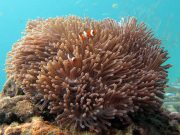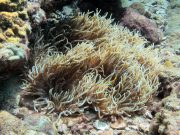Dykning med Tæppeanemoner
Koh Lantas Marineliv | Stichodactylidae
Tæppeanemoner er en gruppe af hvirvelløse rovdyr, som har fået deres navn fra den livlige landlevende blomst, anemonen. Der findes mere end 1.000 arter rundt omkring i verdenshavene på forskellige dybder, og de største og mest varierede findes i de tropiske kystfarvande. De findes i overflod på alle steder på vores Koh Lanta-dykkerture.
Anemoner er en nær slægtning til koraller og gopler og er stikkende polypper med en diameter på mellem 5 og 2 meter og med 10 til over 500 tentakler! De bruger deres tid på at sidde fast på underlaget med en klæbende fod, kaldet basalskiven. Deres kroppe er cylindriske med en række tentakler, der omgiver en central mund, som også er deres anus. De spiser plankton, små fisk og små krebsdyr, der kommer forbi. Den mindste berøring udløser tentaklerne, der skyder harpunlignende filamenter ind i deres offer, indsprøjter en lammende nervegift og fører det hjælpeløse bytte ind i munden.
Nogle dyr har fundet ud af at udnytte forsvaret mod sig selv og har etableret symbiotiske forhold. De mest berømte symbiotiske alliancer er med anemonefisk og porcelænskrabber. De overtrækker sig selv med slim, som narrer anemonen til at tro, at de er en del af den selv, hvilket også gør dem immune over for stikket. Disse partnere lever inden i tentaklerne, som giver beskyttelse, og anemonen spiser resterne af deres måltider.
Nogle anemoner formerer sig ved lateral fission, hvor et identisk dyr vokser ud af forældrene, løsriver sig og bliver selvstændigt. Mange vil dog gyde i vandet, hvor æg og sæd blandes. Ungerne slutter sig til planktonlagene, og når de er gamle nok, slår de sig ned på et substrat.
3 arter fundet på denne side:
Magnificent Sea Anemone
(Heteractis magnifica)

Heteractis magnifica @ Koh Rok
The Magnificent Sea Anemone is found attached to solid surfaces such as rock or dead coral and is found from the shallows to deeper water, usually in exposed areas where medium to strong currents can supply food.
The Magnificent Sea Anemone has a wide oral disc which can reach more than 50 cm across, but most often observed much smaller than this. The oral disc can open to a flat surface, is slightly wavy and is densely spotted with finger-line tentacles which are positioned in multiples of six (member of the six-part corals, Hexacorallia). The tentacles are 5 cm - 8 cm long with blunt or slightly bubble-like tips. The tips may be yellow, green or white.
The Magnificent Sea Anemone can have a variety of colours, with the Basal disc (sticky foot) and column being greyish, greenish or pinkish, purple or brownish. When disturbed, the oral disc will close, with only a few tentacles showing. In extreme cases of disturbance of a change in environmental factors, the Magnificent Sea Anemone can relocate.
Beaded Sea Anemone
(Heteractis aurora)

Juvenile Heteractis aurora @ Koh Bida
The Beaded Sea Anemone is easy to identify because of the numerous small bubbles or beads on each tentacle. In younger specimens, the beads are less developed and the tentacles are shorter, however as the tentacles grow, the beads develop into larger bubbles. Longer tentacles may have many dozens of beads or bubbles.
Since most of the tentacles are in the outer part of the anemone, the oral disc is relatively plain. There can be light brownish radial lines on the oral disc which extend into the sticky tentacles.
The underside of the oral disc and column can be grey-green to chestnut-brown. This anemone displays a variety of colours depending on the surrounding environment and the amount of zooxanthellae in the tissues.
This species can be host to several different species of anemonefish and also to the Three Spot Domino Damselfish (Dascyllus trimaculatus), however it is most commonly observed hosting Clarke’s Anemonefish (Amphiprion clarkii).
The Beaded Sea Anemone is often a temporary home for young clownfish on their journey to find a more suitable host anemone for adulthood, and is also known as a 'nursery' anemone.
Purple Tip Anemone
(Heteractis crispa)

Heteractis crispa @ Koh Bida
The Purple Tip Anemone, or Leathery Anemone, lives between corals and sand covered hardgrounds.
Colour can vary widely and depends on the amount of zooxanthellae in the tissues.
The body column is usually grey and the oral disk is often brownish violet or grey, but can also be bright green, occasionally with white stripes.
The Purple Tip Anemone has long, curled tentacles which become thinner toward the tip, and are positioned in concentric circles on the leathery oral disc. The oral disc and the tentacles have the same colour. The tentacle tips can often show a slightly different colour and may have a tiny purplish or greenish-blue spot at the tip center.
The Purple Tip Anemone can grow up to 30 cm in diameter and feeds mostly on products of its zooxanthellae.
This species is usually found among dead coral and rock rubble and lives in symbiosis with several different species of anemonefish and shrimp (genus Periclimenes).
Dykning med Tæppeanemoner omkring Koh Lanta
Dykning og snorkelture
Hvis du gerne vil have chancen for at se Tæppeanemoner på en af vores daglige dykkerture i højsæsonen fra Koh Lanta, så send os en e-mail til info@diveandrelax.com.
Deltag i vores speedbådsdykkerture i højsæsonen til nogle af Thailands bedste dykkersteder og nyd små grupper, korte rejsetider med fokus på god personlig service, sikkerhed og sjov.
Er du endnu ikke certificeret dykker? Lær at dykke på Koh Lanta med det 3-dages SSI Open Water Diver-kursus.
Book online og spar 10% på dykkerture og dykkerkurser på Koh Lanta.
Få mere at vide
Indo-Stillehavets havdyrsguider
- Allen, G., Steene, R., Humann, P., DeLoach, N. (2003) Reef Fish Identification, Tropical Pacific. Jacksonville, FL., USA: New World Publications, Inc., ISBN 1-878348-36-1.
- Humann, P., DeLoach, N., (2010) Reef Creature Identification, Tropical Pacific. Jacksonville, FL., USA: New World Publications Inc., ISBN 978-1-878348-44-9
- Debelius, H. (2013) Indian Ocean Reef Guide. Frankfurt, Germany: IKAN - Unterwasserarchiv, ISBN 978-3-939767-52-7.
- Debelius, H. (2004) Nudibranchs and Sea Snails, Indo-Pacific Field Guide. Frankfurt, Germany: IKAN - Unterwasserarchiv, ISBN 3-925919-51-1
- Erhardt, H., Knop, D. (2015) Corals Indo-Pacific Field Guide. Frankfurt, Germany: IKAN - Unterwasserarchiv, ISBN 3-925919-69-4.
- Veron J.E.N., Stafford-Smith M.G., Turak E. and DeVantier L.M. (2016). Corals of the World
Flere referencer om havets dyreliv og yderligere information
